Huge thanks to Valerie Anne for the Disney assist when writing and researching this post!
When Beauty and the Beast director Bill Condon said his live-action adaptation of the greatest Disney movie of all time would feature an “exclusively gay moment,” the world went a little berserk. Disney indefinitely pulled the film from Malaysia due to demands from censors, while conservatives in the United States wailed about boycotts and persuaded a least a few theaters in the deep south to drop it. I saw it in my liberal elite bubble of Astoria, New York and the audience lost its collective mind over the gay stuff (in a good way) — even though, in total, it’s a few teensy scenes that add up to about 15 seconds of movie time.
All stories matter, but Disney stories matter, you know? There’s no studio on earth whose characters and costumes and songs are so ubiquitous, so ingrained in us from the time we’re wee tiny babes. Disney movies transcend generations. We grow up on them, no matter when we grow up, and we internalize the messages we receive from them decades before we start to question how narrative shapes our inner lives and broader culture. Disney’s impact is exponential.
Beauty and the Beast isn’t Disney’s leaping off point. They’ve been doing the long, slow dance to just enough for over 50 years. Here’s a timeline of Disney’s crawl from gay-coded villains to live-action LeFou.
Captain Hook, Peter Pan (1953)
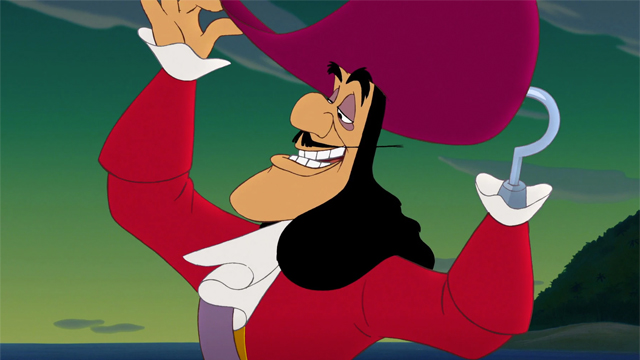
David Thorpe’s documentary, Do I Sound Gay?, traces gay-coded black-and-white sidekick movie characters of the ’30s and ’40s to the gay-coded villains of children’s stories. By the ’50, the “pansy was shorthand for gay,” film historian Richard Barrios explains in the documentary. These “sophisticated, cosmopolitan” men with “proto-gay qualities” span decades of villainy at Disney, and it all starts with Captain Hook. Peter Pan‘s big bad based on the very first gay-coded villain on the big screen: Clifton Webb’s Waldo Lydecker from the beloved 1944 noir film Laura.
Shere Khan, The Jungle Book (1967)
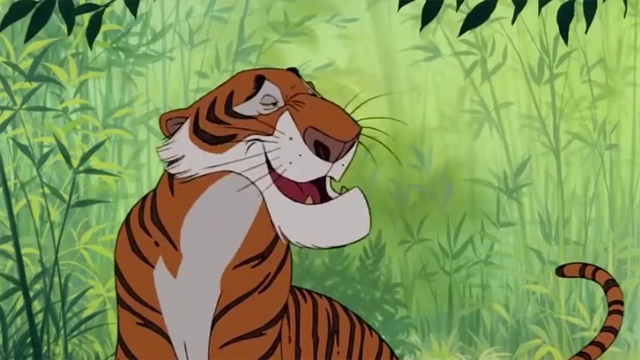
If Laura was the beginning of gay-coded villains, All About Eve, which was released six years later in 1950, was the film that cemented the trope. And if Eve’s Addison DeWitt sounds and acts a lot like Shere Khan to you, it’s because they were both played by George Sanders. Shere Kahn also begins Disney’s animated evolution of stereotypical gay mannerisms. He is “snide, supercilious, superior,” and the genesis of that languid, melodious villain voice.
Professor Ratigan, The Great Mouse Detective (1986)
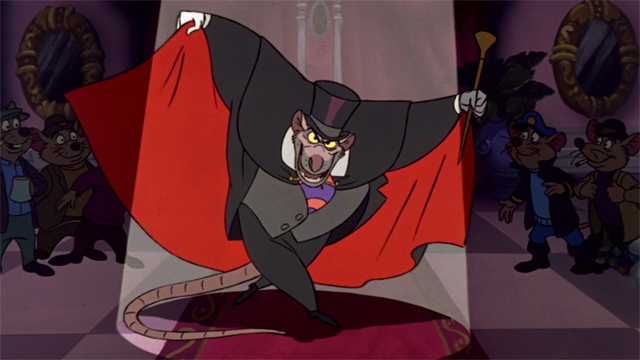
Ratigan takes the gay-coded aristocratic villain to new heights as his fashion choices become more flamboyant and his mannerisms become even more effete.
Ursula, The Little Mermaid (1989)

Did you know Ursula was inspired by drag legend Divine? I did not! Until Phoebe kindly pointed it out in the comments! Did you also know legendary Disney composer Alan Menken wants Harvey Fierstein, who originated the role of Edna in Hairspray on Broadway, to play Ursula in the live-action remake? That’s what he told the UK’s Gay Times just this week.
Jafar, Aladdin (1992)
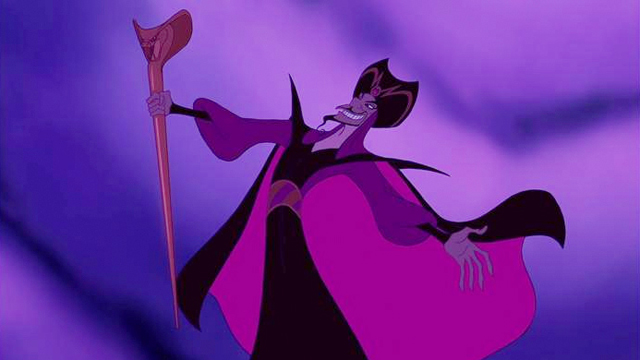
Ratigan was the beginning of the sibilant S in gay-coded Disney characters, but Jafar owned it, leaning into it and drawing it out like the snake at the end of his staff.
Scar, The Lion King (1994)
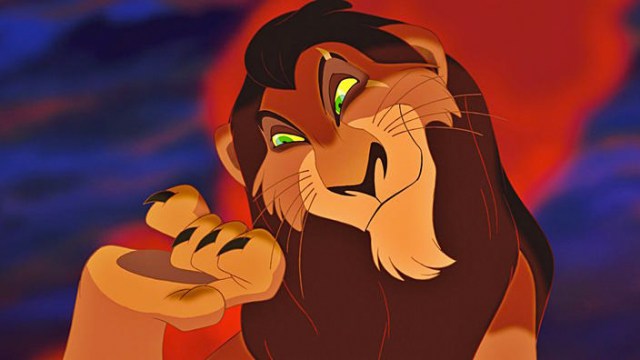
Much like Disney’s Golden Age, its gay-coded villainy peaked with The Lion King. Scar is the ultimate gay baddie; he literally murders a tiny, adorable lion’s giant, adorable father. Scar embraces those “little floaty cadences,” and gives those P’s, T’s and K’s all the crispness he can. He has no interest in women, only power. When he promises to practice his curtsey, Zazu shudders “There’s one in every family.”
Hades, Hercules (1997)
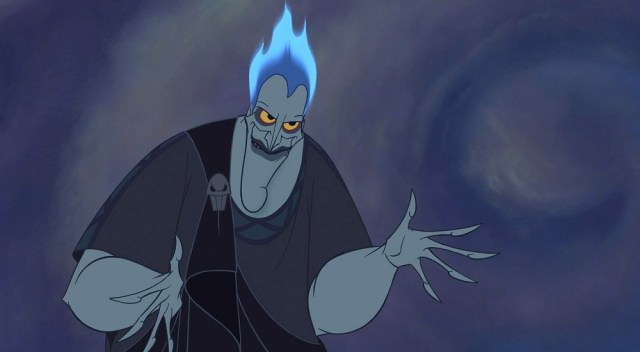
Hades is the natural evolution of the Hooks and Scars before him, plus: He’s literally flaming. The early aughts loved a sassy gay best friend more than anything. Hercules would have thrived on Sex and the City.
Li Shang, Mulan (1998)
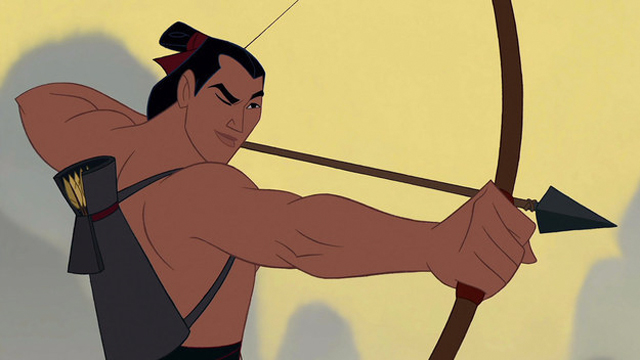
No one ever says the word “bisexual” in Mulan. And no one at Disney has ever said the word “bisexual” about Mulan. But Li Shang was in love with Mulan when she was disguised as a dude and he thought she was a dude, and he was in love with a Mulan when she revealed herself as a woman. In the real world, we call that “bisexuality.” In Disney fandom, Li Shang is a bisexual icon.
Dory, Finding Nemo (2003)
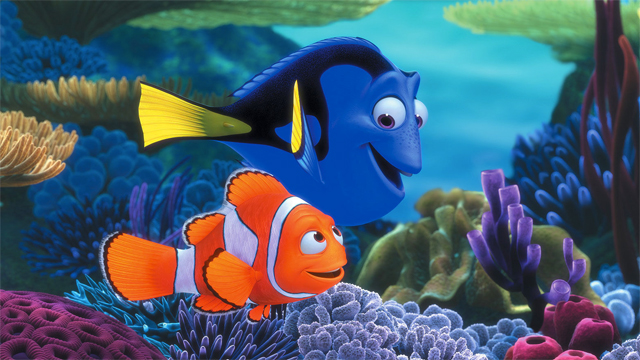
Dory may not be queer, but she is voiced by the most famous gay person in the universe. I remember seeing Ellen on a late night talk show not long after she came out in 1996 and the host asked her about the boycotts conservative Christians were threatening of Disney World since Disney-ABC distributed her show. She laughed it off and said Baptists would boycott pencils if they found out she was writing her show with them. The Religious Right made her the main target of their Bill Clinton-era culture war, but she had the last laugh, relaunching her career on the back of the critically acclaimed, eternally beloved, family friendly Finding Nemo.
Remy, Ratatouille (2007)
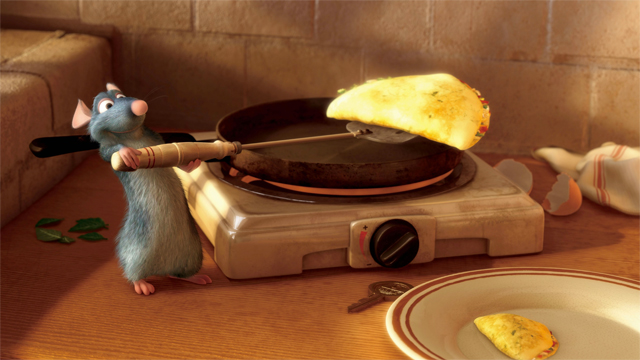
In Disney’s behind-the-creative-scenes book, The Pixar Touch, director Jan Pinkava reveals that Ratatouille was conceived as a coming out allegory, which makes perfect sense. He’s a rat who’s very different from the rest of his family. He’s got a secret. And when his brother finds out, his family shuns him for his desires and he leaves home to go to the big city where he can finally live as his true self. He’s Disney’s first gay hero.
King Candy, Wreck-It Ralph (2012)
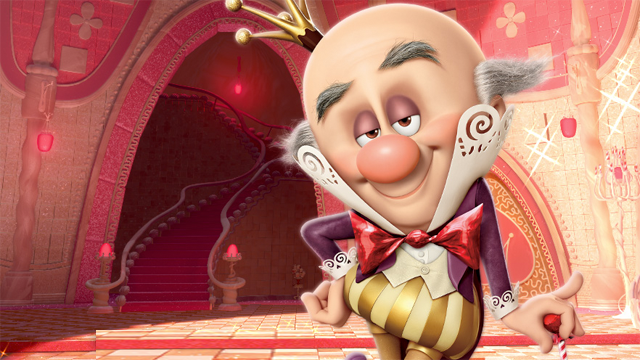
King Candy is David Thorpe’s choice for worst gay-coded Disney villain. While promoting his documentary, he told the Washington Post: “He is very conspicuously effeminate. At one point in the film the hero even refers to him as ‘nelly wafer.’ (This is a play on a ‘Nilla wafer’ – a kind of cookie – and the word ‘nelly,’ a derogatory term for gay men.)”
Oaken, Frozen (2013)
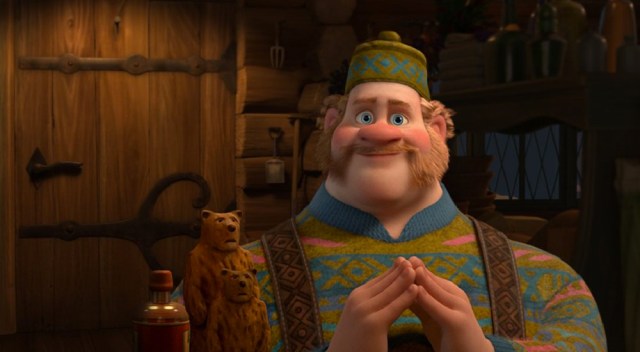
Before there was the #GiveElsaAGirlfriend Twitter campaign, there was Oaken, waving to his family in a portrait. Four children and a husband. It’s a brief, blink-and-you’ll-miss-it scene, but it’s there.
Mulan, Once Upon a Time (2014)
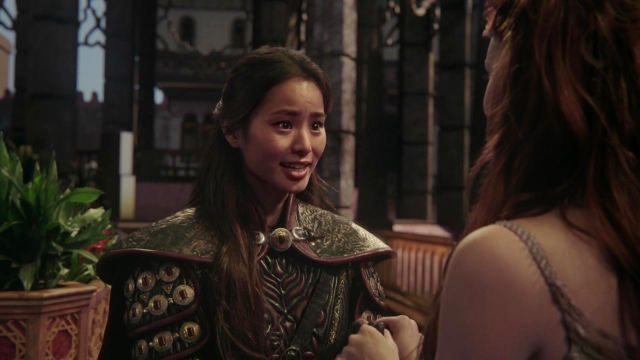
After Mulan first revealed that she had big gay feelings for Aurora, she walked off camera and seemed to disappear like some kind of Erica Hahn into Grey’s Anatomy‘s Parking Lot of No Return. But she finally came back (years later!) for a few episodes and her friends made out with each other.
Lesbian Moms, Good Luck Charlie (2014)
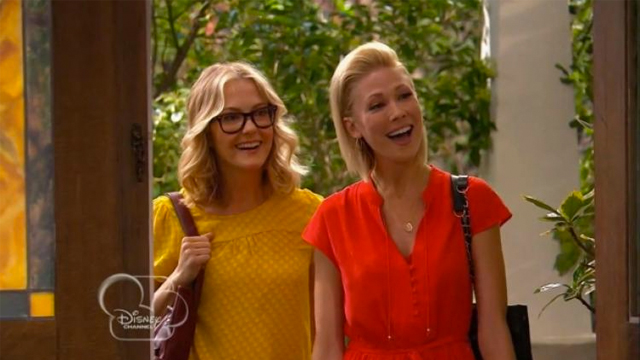
During its final season, Good Luck Charlie introduced gay people to the Disney Channel. Charlie’s parents invited a kid over for a playdate and he was joined by his two moms. It threw Charlie’s dad, Bob, for a loop, but when he realized what was happening, he rolled with it. He didn’t have an issue with the lesbians; he was just surprised that they existed.
Dory, Finding Dory (2016)

Same as Finding Nemo, but Ellen had taken over the world by the time Disney got on board for the sequel. This time she wasn’t building off of Mickey’s brand; he was building off of hers.
Star vs. The Forces of Evil (2017)
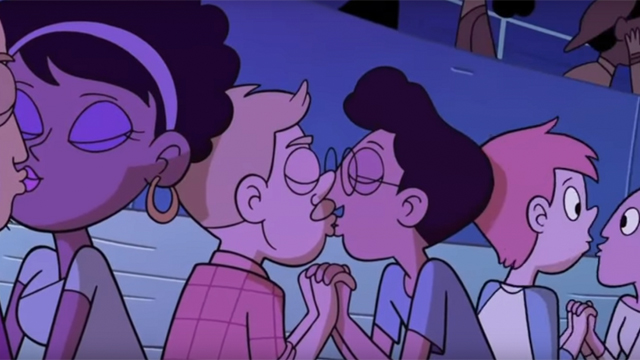
Just a few weeks ago, during a dance montage, to the tune of the original song “Just Friends,” Disney aired its first same-sex kiss. Two no-name characters smooched on the lips as the camera panned by during an episode of Star vs. The Forces of Evil on The Disney Channel.
LeFou, Beauty and the Beast (2017)
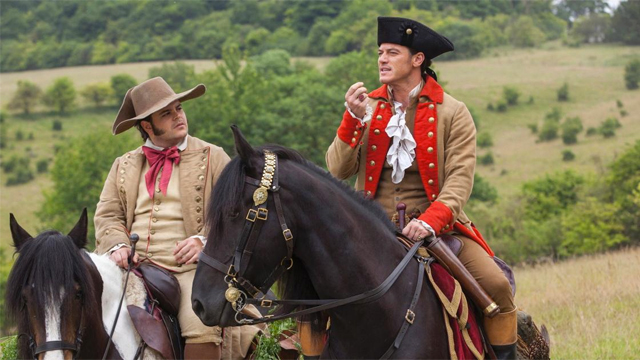
If you weren’t looking for it, you might have missed the gay stuff that sent Evangelical Christians screeching toward their fainting couches during Beauty and the Beast. A quick, forlorn look when Gaston asks LeFou why a woman hasn’t scooped him up yet. Ms. Potts telling LeFou he deserves better. The smile on the supporting gay characters’ face when the wardrobe attacks him and his friends with dresses and they run away shrieking while he grins into the drag. And the very brief moment when that same guy, wearing a tux, swoops in to dance with LeFou in the final scene. It wasn’t much, but it was something real and canonical (as opposed to the speculation that came from LeFou being very clearly obsessed with Gaston in the animated film) in one of the most anticipated Disney movies of all time in a year when homophobia seems to be all the legislative rage again. Plus: Director Bill Condon insisted that LeFou have a change of heart and become a good guy before his big gay reveal. Condon also told Vanity Fair that openly gay composer Howard Ashman — who co-wrote the original film’s music with Alan Menken and died of complications from AIDS before it was released — saw Beast as a metaphor for AIDS.
Beauty and the Beast doesn’t solve our representation problems, but it’s a very welcome change of pace from the decades of homicide committed at the very well-manicured claws of the gay-coded villains of Disney past.



Mulan wasn’t the one who became Red’s girlfriend on “Once Upon a Time”. That was Dorothy Gale, so Red really is “A (girl)friend of Dorothy”
Holy cats! That’s what I get for getting all my OUAT news from fan fiction. :/
which is really the only way to get ouat news without compromising your well-being
That freaking storyline was so frustrating, they built up some shit between Ruby and Mulan (who has been patiently awaiting any semblance of a happy ending of her own to no avail) and then pair off Ruby with some strange Katniss Everdeen knockoff character in a one-off episode. WILL SOMEONE PLEASE GIVE MULAN A GIRLFRIEND?
Is it too obvious to respond to this comment with “I VOLUNTEER AS TRIBUTE”? Probably, but I’m going to do it anyway.
Okay he turns good but really it still should have been Cogsworth/Lumiere
Hercules was my favorite movie as a child, so much so that I actually wore out the tape.
Wait…Ursula was totally gay too, wasn’t she? Just wishful thinking on my part?
I thought so!
I mean. Everyone who has ever been a part of their local LGBTQ organization knows this woman:
Locally her name is Rhonda.
OMG YES EXACTLY
Ooh, also, bonus, you’ll never convince me these two from Dreamworks’ Prince of Egypt aren’t murder husbands.
She was modeled after 80’s drag queen Divine! That’s pretty gay.
ohhhhhhhhhhhhhhh
yas we have an article for that! Evil Disney Queens Are Doing It For Themselves
You have an article for literally everything! How do you even remember those?
(Unrelated to this post, but you need a bot that counters angry comments with a pertinent article).
professor ratigan?!?!? no way
wish I could upvote this more than once
Ursula was based on Divine! I once did an essay on Hairspray so I have a lot of latebt Divine knowledge.(it was on gender in the performing arts, and I managed to swing it so mine was comparing the two Hairsprays. I am still really proud of that fact)
This is so cool. I can’t believe I didn’t know it. I added it to the post. Thank you for this information!
I am fangirling hard that my name is in an Autostraddle article!!! E
I’ve said it before and I’ll say it again: Ellen DeGeneres had the greatest comeback in Hollywood history
And I have thought of Frozen as a coming out story (AE even had a whole article about it) but not Ratatouille. That was eye opening. Thank you
Just wanted to pop my head in to say that I’m still mad about how dirty OUAT did Mulan(and subsequently Red/Dorothy who were essentially used for a queerbait-y “We are totally not homophobic!” very special episode never to be seen again) and haven’t watched the show since.
Fun article, thank you!
Timon and Pumbaa, come on. They’re pretty much canon now thanks to the show The Lion Guard in which they’re adoptive “uncles” to Kion’s friend Bunga.
Also, Hugo the gargoyle from Hunchback of Notre Dame is in love with Esmeralda’s male pet goat Djali.
Timon and Pumbaa, total gay dads
The Lion King was my favorite movie growing up and I’m sure it having like, three very gay characters had NOTHING to do with that nope not at all.
I can’t believe I never thought about bisexual Li Shang before. Now I love Mulan even more.
lady villains like maleficent and ursula are definitely gay too. they try to fuck with ill-conceived het romances, they have the most intoxicating voices, and they’re smart enough not to throw their lives away on a dull af prince they’ve never even talked to. they harness their bitter outcast status to wreak havoc on the state, and that’s something i still aspire to after all these years.
Listen: any article about the history of gay coding in Disney that doesn’t mention Howard Ashman’s influence is erasure, full stop.
Howard Ashman wrote the entire soundtrack to my childhood. Fuck AIDS, man.
Erasure? Come on. Ashman and Menken wrote the brilliant music for The Little Mermaid, Beauty and the Beast, and Aladdin — but they didn’t have anything to do with Disney’s acting or animation, which are the things we use to ID coded gay characters.
Lyrics can be used to ID coded gay characters – and should for Ashman in the very films you cite.
In addition to HFM’s accurate comment (Beauty and the Beast producer Daun Hahn has said the lyrics to the Mob Song are “almost a metaphor” for AIDS stigma, not to mention stuff like “You can ask any Tom, Dick, or Stanley, and they’ll tell you whose team they’d prefer to be on”) Ashman DID have to do with the animation AND acting. You denying that is not only erasure, it’s demonstrably inaccurate. If I was going to nitpick just over a lyricist being gay, I’d have mentioned the lack of Elton John.
Re animation: He wasn’t just a lyricist, he a producer on Mermaid. he was the one who suggested one of the Dynasty women serve as a model for Ursula, then Divine–a choice tied to his heritage as a gay man in Baltimore. He also taught animators the “misfit tells audience what they want early on, audience falls in love with misfit and roots for their goal” structure which is gaycoded and still used in Disney today, as you pointed out with Remy the rat.
Re: acting, he also instructed Jodie Benson on how to say every one of Ariel’s lines, while in the booth with her– so much so that she’s said “I don’t take that performance as Ariel as mine, it’s not mine, I just got to embody it as an actress, but it was handed to me, spoon-fed on a platter, by [Howard Ashman].”
There’s a lot more I could go into, but my point is: thanks for editing to include him, but make sure you actually know what you’re talking about before you take a condescending tone with someone trying to point out when you’ve messed up. I used to really like your PLL recaps, but I don’t know if I can trust anything you write anymore if your response to one critique is to publicly post misinformation.
Wow, you have major problems if you can’t bear to have someone counter your claims without throwing a hissy fit. You come off as not only inexplicably hostile, but also someone who implies some sort of agenda (misinformation, erasure) on the part of one of the most valiant and vocal LGBTQ advocates we have. And why exactly? What’s your problem? It’s people like you who discourage the Heather Hogans of this world – and we need them more than we need your condescending self.
I think Heather started off the hostility… Her reaction to being told she was erasing Ashman was to out of hand dismiss it, even though the facts show she WAS wrong to not include him in particular as he had an undeniable role in establishing the queer coding techniques used in most of the examples Heather sites. When we really need to constantly point to real people and say their names, not saying Ashman’s name IS erasure – it’s why Sam Smith (or… whatever his name is… Harris?) thought he was the first openly gay man to win a Best Original Song Oscar. When she said “they didn’t have anything to do with… the things we use to ID gay coded characters” she was blatantly wrong. Misinformation is misinformation no matter who’s saying it, and this situation would have been handled just fine had Heather gone, “You make a good point and I apologize for excluding them, I’ll edit to add.”
Explain to me how it’s not erasure or misinformation to say someone didn’t do something that they did. I provided evidence to back up my claim that the information wasn’t true. I stated her response made me more skeptical of her, after previously agreeing that her work was great. All I’m discouraging here is giving people inaccurate information. Women who aren’t straight have very little access to true histories about gay people– having an advocate for the community add to that problem by say things that are factually untrue on her large platform is my problem. I don’t have a problem with Heather. I wish she’d apologize for her error, and be more careful not to make assumptions about facts she hasn’t verified in the future. That’s all.
why “erasure” and “misinformation,” tho? why always straight to the harshest possible language?
why not say, “an angle I’d really love to see explored in an article like this is so and so’s contribution to Disney canon as a gay man.” Why straight to language that assumes the worst?
I’m not just asking you, I’m honestly asking the whole damn internet
I can understand why “erasure” has strong connotations– I chose it because it’s a really big oversight not to mention him, because this entire article is inspired by the new LaFou, whose sexuality is in turn is heavily implied to be inspired to honor Ashman’s. Ashman originally wasn’t even name dropped in the article, now he is, and I’m satisfied with that.
I wouldn’t ask like that because that’s asking for an entirely different article. I guess I could have said “Howard Ashman should be mentioned in any article about gay-coding,” but that doesn’t convey how shocked and appalled I was accurately.
As for “misinformation”– that is FAR from the harshest term I could have used. In fact, I consciously chose not to say “lying,” or “falsehood,” because those both imply she was saying something untrue on purpose. I don’t think she was. That doesn’t make her claiming things that aren’t true okay.
Okay, thanks for answering! I guess my next question is, why were you ‘shocked and appalled’ by the omission? This is essentially a listicle on the internet. I can see being surprised, or even bummed, by the omission – but ‘shocked and appalled’ sound like outrage. I guess I’m just not understanding why the language of the internet these days is so much about outrage, why each omission or disagreement feels so very personal to many readers. Obviously you can’t answer for the internet. :-) I just feel like we’re all we have, so why not use language that gives the people creating content for us the benefit of the doubt?
Also, in the interest of not assuming the worst, I’m going to assume you didn’t say “so-and-so” because you missed the irony of doing so in a discussion about erasure. I wish you had said “Howard Ashman” instead.
(This is in reply to queer girl’s second comment, but for some reason I can’t reply directly. Sorry for any formatting confusion).
First, unsarcastically: thank you for acknowledging I can’t answer for the whole Internet, it lets me know you actually want to listen to me and not just vent ?
To answer your question: it’s not just a listical *anywhere* on the internet, its a listical on a website for non-cishet women, by non-cishet women. I get straight platforms not acknowledging Ashman, even if it’s upsetting. But a gay one? While people are calling for boycotts of the new movie, how is it acceptable for an article on Disney’s gay timeline, on a gay platform, to not point out that gay subtext in Beauty and the Beast is nothing new, specifically because of a real, gay, person? Especially a listical that clearly involved outside research? As one commenter already mentioned, Sam Smith claimed in his Oscar speech that he was the first openly gay person to win the award. When it was pointed out to him that Howard Ashman had won his category before, Smith replied, “Maybe we should date,” because he didn’t know Ashman had died of AIDS before he even got to see Beauty and the Beast. That incident only happened a year ago, and despite the wide media attention it got, it’s still not common knowledge that Disney would have gone bankrupt if it weren’t for a gay man (and a lot of his successful choices were gaycoded or informed by his gayness). Again, I didn’t and don’t expect someone to write someone’s entire biography in a listical. But how can he ever get the widespread attention he deserves, if an article on the history of gay coding in Disney, on a gay website, won’t even drop his name? And it’s not like the author of the article hadn’t heard of him, bc the interview linked at he top mentions him extensively. That’s why I was so vehement, because all evidence suggests she should have known better. This is also why I didn’t give her the benefit of the doubt.
You didn’t ask anything further about saying misinformation, but I just wanted to point out that this trend of the significance of Ashman’s contributions being ignored or downplayed is why it’s especially bad Heather claimed he had nothing to do with the acting or animation. That’s why I replied with so much information on why that was factually inaccurate. Thanks again for hearing me out.
P,s., spoilers for the new beauty and the beast: knowing about Ashman also adds gay subtext to the new film. There’s an added plot about What Happened To Belle’s Mother, and it’s revealed she died of “a plague,” that her father shouldn’t have tried to keep that from her.
I think maybe an analogy might help make my point. I don’t know too much about Steven Universe or Adventure Time, but imagine if a gay website did a listical about the timeline of gay-coding on Cartoon Network, but they didn’t include anything that happened on any of Rebecca Sugar’s shows except for a character way less overtly queer than any of the gems or Bubbiline, and didnt even mention Rebecca Sugar’s name, let alone that she’s bisexual. Now imagine that on top of that, no one ever talks about Rebecca Sugar, even though she saved Cartoon Network from bankruptcy. And on top of *that*, imagine if she had died in the prime of her career from an illness stigmatized bc it’s associated with queerness. THATS what not mentioning Howard Ashman is like.
And claiming Howard only did the music/that didn’t code anything as gay is like claiming Rebecca Sugar didn’t gay code anything because she just wrote “I’m Just Your Problem,” and only animation and acting gaycode. Not only are her lyrics gay coded, but she did lots of other things– saying otherwise is misinformation, and requires a correction and subsequent apology.
@Vicki thanks for talking with me! I guess I’m just still confused at your language choices. “Unacceptable” and “should have known better” are shaming phrases, implying that the author is at great fault, and that you were personally harmed by that fault. I just don’t think that the fact that Heather’s parameters for this list weren’t the same as yours, or that she may not have known the full extent of mr. ashman’s contributions to the characters, can possibly warrant the kind of upset you’re telegraphing with the language you’re using. Maybe I just don’t understand this outrage trend. This is a list with some characters on it, and you think one of their creators should be included, and that’s great! Tell us about him! But this isn’t something that somebody DID to you.
Whoops I tagged the wrong Vicki, I think!
Well, you did it Vicky! You went back in time and solved the AIDS crisis and came back to the present and defeated Donald Trump, leaving nothing but positive change and empowerment in your wake. You really showed Heather Hogan, didn’t you? Here she was trying to act like she knew something when she had no idea who Richard I fucked. I’ve been following her career for eight years and watching as she’s put her heart and soul into everything she’s done to try to make the world a better place for queer women OR SO I THOUGHT. You finally revealed her long game today: She’s been working to erase Howard Ashman (nay AIDS full stop) from history. The world is so much better now. I’m not even scared of the healthcare vote tomorrow. WAY 2 GO GIRL! YOU DID IT!
its weird how most comments have accused me of being too harsh, and then there’s this one, posted 5 hours after I already conceded the Richard I thing was unfair, and with my name deliberately misspelled.
What I genuinely don’t get is, I’ve said I’m a fan of Heather’s work, and the statement I’d say was the harshest I’ve made is that “you’re better than this, and you’re readers deserve better.” So why are u acting like I’m some mean-spirited troll deliberately trying to be a bully? If I was a bully, I’d say she sucks. She doesn’t suck. She can do better, she usually tries to do better, and I’m realizing now maybe even w citing sources that him it wasn’t clear why it’s important to include him. That’s why I submitted the comment comparing him hypothetically to Rebecca Sugar. I really hope it’s an issue of people overreacting over My Fave or whatever and not people choosing to attack anyone with constructive criticism of Heather Hogan. Especially since she’s been an LGBTQ+ advocate for over 8 years— she’s dealt with worse shit than a 24 year old lesbian Broadway geek pointing out that someone did a hell of a lot more than write lyrics.
Now we arrive at the crux of the problem. I did not deliberately misspell your name. My mom’s name and my sister’s middle name is (are?) Vicky with a Y. But you immediately jumped to assuming you were being attacked when it was a simple mistake. I have been spelling Vicky with a Y all my life. So maybe the lesson here is that your impulse is to assume people are out to get you or are intending to do harm so you jump to 11 and use needlesly agressive and accusatory language. What you’re going to receive from that kind of paranoid behavior is defensiveness always. Maybe enter a conversation with some tact next time, assuming good intentions. If you really are a fan of Heather’s work, you know she’s never purposefully causing anyone harm. Show some good faith and you’ll be shocked by the results.
Here’s what I don’t understand, Vicki: If you know my writing, and you know my reputation for learning and growing and listening, and you know I constantly deal with “a lot worse” than what you wrote here, why in the world didn’t you just approach this conversation by simply asking if I was aware about the sexuality of medieval kings/folklore heroes, and Howard Ashman’s full contributions to The Lion King? Why in the world did you come in yelling that our readers deserve better and accusing me of erasure? How did you expect me to respond to that? Because the truth is I do get “a lot worse” than this. I get comments on my instagram telling me to kill myself. I get comments on my instagram saying, “I hope your cats die soon.” And, “I hope your cats drown in a vat of acid.” I get tweets threatening to rape me or telling me I’m too fat dykey to be raped. And every single time I make an unintentional mistake, or overlook something, or come in hot (or not hot enough) on whatever social justice social media is pissed about that day, people in the queer community fly in here and start accusing me of various nefarious things. So you want trans women to die? So you want sex workers to get murdered? And on and on and obviously I don’t want any of those things.
So you know that, right? You know I get vile hatred spewed at me and you know I get the outrage of the moment from whatever people are upset about, yet you STILL thought the best course of action was to come in here and accuse me of erasure? To tell me my readers deserve better? And you think I should have responded with, what, a smile and a pat on the back? What did you hope to accomplish with this tactic of communication? Your line of reasoning seems to be, “Well, there’s nothing wrong with it because you can take it.” Or, “There’s nothing wrong with it because some people are a lot meaner than this.”
Try to remember there are human people dealing with all sorts of human struggles behind the words you read on the internet. Try to treat us with a little bit of empathy and grace. You could have made your point about Howard Ashman in a way that allowed us all to celebrate his life, you know? We could have all come away from this feeling hopeful, instead of even more exhausted and attacked.
This comment has been removed as it is in violation of Autostraddle’s Comment Policy. Repeat or egregious offenders will be banned.
Great article! I was a kid seeing some of these movies and I missed a lot of these. Speaking of missing things, I saw Beauty and the Beast and did literally miss the quick “gay dancing scene” in the end because I turned to say something to my wife. Guess I’ll have to go back and see it again. Just for that. Not because I loved it or anything…
Usually, I just refrain from commenting on articles I disagree with. And Heather, you know I love everything you write. But I gotta say, I was really disappointed in this article. Skimming the headline quickly, I though it was going to be about the “long, slow evolution” of Disney never being queer enough. I’m surprised to find that you are giving Disney so much credit for a 15 second, blink-and-you-miss-it “gay moment” with a character who’s name literally means “the fool”. Is a gay fool really any better than a gay villain? Are those 15 seconds really worthy of the hype Disney gave them, or were they just trying to sell tickets, without having to ACTUALLY deal with the backlash of having a queer character. And if Disney can make LeFou gay, why the hell can’t they give Elsa a girlfriend?
I don’t know, maybe I’m just being too cynical and I should accept the scraps that Disney doles out. But really, I’m not going to be happy until Disney has a queer protagonist, or at the very least, an explicitly queer character who is more than the villain or the comic relief. And I just hope that maybe the reaction to LeFou (which, save for Malaysia and a few theatres in Alabama, has mostly been positive) helps show Disney that yes, the world is ready for a queer Disney protagonist. Because now they have literally no excuses left.
But anyway, that’s for putting this together, still a really interesting dive into Disney’s queer history, which I do appreciate.
I was thinking the same thing, thanks for pointing this out. This article was disappointing.
LeFou actually translates to mad man
On a much smaller note, it’s kind of absurd to include Jafar– one of the few Disney villains to actually express interest in women*– but not point out that Robin Hood’s Prince John is a thumb-sucker who frequently wails “Mommy!” and is mocked for being a “dandy-lion”, despite the historical John hating his mother and having 5 children by different mistresses. Meanwhile, “Good King Richard’s” brief appearance isn’t coded at all, despite accounts he had sexual relationships with both men and women.
It’s just really frustrating that additional people were brought into research this article, but other than including quotes to back up interpretations that anyone with cursory knowledge of gay stereotypes could make, there’s no actual *history* in this “historical analysis.” Very disappointing, especially since I’ve seen better histories of gayness in Disney from *straight* websites (literally HOW do not one but TWO people miss designing Ursula off Divine???) You’re better than this, and your readers deserve better.
I mean “additional people” weren’t “brought in to research this article.” I talked to Valerie in Slack for a couple of days about various things we’ve seen and read about Disney movies over the course of our lives. For research, I read film historian Richard Barrios’ Dangerous Rhythm, Simon Callow’s Screened Out, watched Do I Sound Gay, and revisited The Pixar Touch. (Which, frankly, is more research than you’re going to get on every other pop culture website writing about LeFou, combined.) Barrios’ is one of the most renowned scholars of gay cinema in the world and he’s the one who introduced Jafar into this conversation. Maybe Disney’s King John belongs on this list, but it seems a little absurd to be like “You’re better than this, and your readers deserve better” because I didn’t do a deep dive into the real life rumored sexual history of medieval kings and heroic outlaws.
“But it seems a little bit absurd to be like ‘you’re better than this and your readers deserve better than this”
Im not disputing the validity of your sources, and I thank you for your effort for providing context to certain mannerisms. My issue, however, is not that a pop culture website didn’t do more extensive research, but that it overlooked very basic trivia. Multiple Buzzfeed lists, the AV Club, and other pop culture sites have all mentioned the Divine/Ursula connection (thank you for editing the list to include her). You’ve also edited the article to include info about Howard Ashman–equally well-known, and cited in one of the articles you linked to– and I thank you for that.
I acknowledge Jafar vs John is not a hill worth dying on, and that Jafar should be on the list, especially since he’s more well known than John. Because characters from equally obscure Disney movies made the list (Ratigan, for example), I was surprised John didn’t, but I concede that might be unreasonable. I do, however,object to the term “deep dive”–while considering Richard might be a bit much, would take to get that info on John is watch the movie and think, “wow, this is stereotypically gay, was the real John gay?” and check the personal life section of his Wikipedia. I figured someone had seen Katherine Hepburn in Lion in Winter re: the mom part, since she’s such a non-hetero icon, but that’s definitely a reach.
Also, I’m not sure your description of Slack etc contradicts what I said, especially since this article starts with “huge thanks to Valerie Anne for the Disney assist when writing and researching this post. I’m thinking you just meant it wasn’t a super formal process? If so, that’s cool.
I tried to be pretty clear that this isn’t some kind of gay revolution. I called it Disney’s “dance to just enough” and described it is “a few teensy scenes that add up to about 15 seconds of movie time” and also said “If you weren’t looking for it, you might have missed the gay stuff.” To me, talking about what actually happened in Beauty and the Beast and providing historical context for it is about ten billion times more interesting than writing another NOT GOOD ENOUGH tirade. A hundred of those posts and articles already exist all over the internet. I didn’t even hint at the idea that Disney has now arrived, fully evolved, changed the world, created an organic and fully realized gay character that will stand the test of time! But I do think it’s genuinely important that LeFou — who was played by every little girl’s favorite cartoon snowman — does have this tiny gay awakening. Something this small would have had an ENORMOUS impact on me when I watched the original film a thousand times as a child. Anybody can write an angry rant about why something’s not enough. It’s easy. I want more.
Thanks for the reply, Heather. You’re right that another “this isn’t good enough” article isn’t that interesting, and has been done to death elsewhere. I guess I just disagree with you about the importance of LeFou’s gay moment. If this proves to be the catalyst that causes Disney to launch a future queer protagonist, then I think it will be important, and if you’d written about the importance of that moment from this angle, I would have no complaints at all. But until that happens, I ‘m very reluctant to give Disney too much credit for what’s really nothing more than a sweeps-type marketing ploy with a foolish side-kick. And let’s be real, I seriously doubt many little kids are gonna make the Josh Gad connection to Olaf the snowman.
I’m actually really disappointed because Howard Ashman, who wrote the music and lyrics to Beauty and the Beast, passed from complications due to AIDS right after the movie’s release. His partner Bill Lauch, actually accepted the various post-mortem awards in his stead. Beauty and the Beast was dedicated to Howard, and in knowing this, Beauty and the Beast had a huge opportunity to do his memory an honor that they missed.
Also: the original Beauty and the Beast had a HUUUGE impact on me, regardless of the lack of gay moments. That bookstore?! That library!? SWOOOOOOON. My friends and I have a joke that Belle’s opening scene in the bookstore, on the sliding ladder, is the scene that launched a thousand English Lit majors. One day, ONE DAY, I will have a house that is big enough I can install my own sliding ladder. THAT IS THE DREAM.
OMG, YES, THAT IS THE DREAM.
I loved this article and everything about it!
Disney’s slow journey to finally coming out.
ok but what about the baseball scene in high school musical 2? THAT’S “exclusively gay moment” if any
SECONDED
“I’ll show you how I swing!” Actual song lyric. Also, I might be obsessed with that soundtrack.
I never noticed any of this as a child, and it now seems crazy that I didn’t?
This was interesting. Thank you Heather.
WHAT THE HECK HEATHER, I was *just* talking about this EXACT PHENOMENON (which Disney villains are queer-coded, and is LeFou “good” representation in this awful hateful time) with friends YESTERDAY AFTERNOON. ARE YOU IN MY BRAIN????
Seriously, though, thank you for this timeline!!! Bisexual Li Shang forever and ever amen.
It’s also weird how a lot of those gay-coded Disney villains were British
Like, Scar was the only British lion in all of Pride Rock
Scar was Musafa’s BROTHER and yet they had different accents, I just realized that.
Maybe they had a Parent Trap-type situation growing up
Maybe he got sent to Boarding School in a British Territory as a cub?
I never realized that!!
Maybe this is why I moved to the UK? I grew up thinking all Brits were gay…
…and evil?
…but fabulous!
Next queer Disney characters: SwanQueen.
(I’m so deep in the queerbait hole I’m expecting to see tardy rabbits any day now.)
(This ship is like the Flying Dutchman. I’m trapped for eternity.)
The voiceover star of Ursula for the Latin American dubbing was Serena Olvido -according to a few online sources she was a drag queen and according to an article that I’d read a long time ago, she was a transgender woman.
Unfortunately, there isn’t any more information available about her, but I was very happy to learn about this and I wanted to share with you.
I want ‘Gay Disney Villian’ on a t-shirt. Also this article is EVERYTHING.
Hi, I’d like to add two to the list. Gobber from ‘How to Train Your Dragon’ and Mitch Downe from ‘Paranorman’ who is a major character and outright mentions his boyfriend.
How to train your dragon is Dreamworks. :(
The Oaken family is in a sauna! You can see them through the sauna window, not in a picture
We need more goodies to be at least queer coded.
This room is too noisy so I can’t concentrate enough to remember names but the candlestick and clock from beauty and the beast were queer coded though surely?
Cogsworth and lumiere. And i should’ve remembered that as we have a cat originally called lumiere (long story).